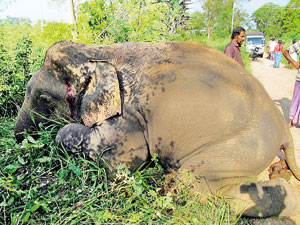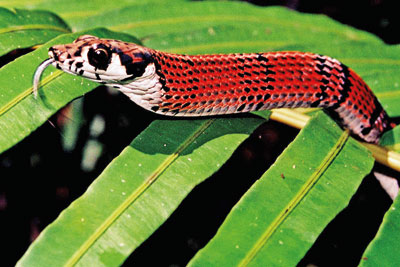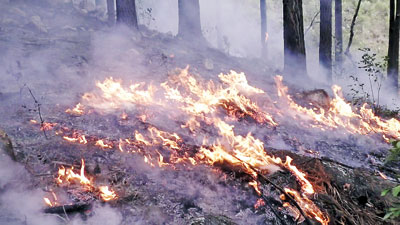
Co-habitation between man and elephant the only answer to solve HEC
Co-existence is the one and only answer to the human-elephant conflict (HEC) and weaving this into the development plans of areas in the grip of HEC is the need of the hour.
This is the firm belief of the Chairman of the Centre for Conservation and Research (CCR), Dr. Prithiviraj Fernando who has been conducting research on elephants for over 25 years.
The mitigation of the HEC is not the duty of the Department of Wildlife Conservation (DWC) alone, he tells the Sunday Times when we catch up with him in Galgamuwa.
Citing Wayamaba (North Western Province) as a ‘classic’ example, Dr. Fernando points out that there are a couple of million people, houses and home gardens, about 200,000 acres of paddy and around 2,000 elephants in an area of about 750,000 hectares. Everybody expects about 50 DWC officers in Wayamba to prevent the HEC. These officers are stretched and strained to their limits trying to “conserve people and their property” rather than doing their job of safeguarding and conserving wildlife including elephants.
“The HEC has to be handled by the appropriate stakeholders, with the people who suffer due to the HEC taking the primary measures to address the problem. A major role in mitigating the HEC has to be played by officials and agencies whose responsibility is the ‘people’s welfare’. They would include administrative officials such as the District Secretary, the Divisional Secretaries and their teams including the Grama Niladharis; the development agencies such as Mahaweli, Agriculture and Irrigation Departments; and also the Disaster Management authorities, as the HEC is a man-made disaster. Conservation agencies can and should only play a secondary role,” he says.
Dr. Fernando laments that unplanned development, which is encroaching more and more into the homes of wild elephants, is creating a crisis in the area. There are large-scale encroachments by influential Colombo people and companies who are acquiring land in the area and cultivating large extents. This takes away the limited elephant habitat and obstructs elephant movements. Consequently, there is confrontation and conflict. The moment someone gets killed there are protests against the DWC and a clamour for the elephants to be taken elsewhere.
But that is not the answer, the Sunday Timeslearns. These wild elephants have been in the area from time immemorial. It is almost impossible to remove them by force from their ‘traditional homes’ and incarcerate them in Protected Areas elsewhere. If that is done they do not survive. Like in other parts of the country, countless elephant drives have been carried out in Ehetuwewa and Galgamuwa areas annually. The DWC is forced to continue this activity although such drives are futile and, in fact, increase rather than mitigate the HEC.
(Elephant falls victim to the wrath of villagers)
Thereafter, some of these free-roaming elephants have been fenced in, limiting their range to the Inginimitiya reservoir and the teak plantation in Galgamuwa and preventing them from utilizing half their home range on the Ehetuwewa side. As a result the elephants have no recourse, but to break the fences or starve to death. In such situations, it is the problem-causing male elephants that break the fences and continue their depredations, but the innocent female herds and young which suffer.The CCR had facilitated the DWC to track a number of elephants using radio collars which clearly showed that the elephants refused to leave and/or kept returning to their ‘traditional homelands’ where they had lived all their lives, being born, eating, drinking, mating, producing babies, growing up and dying.
Making matters worse, the Sunday Times understands, is that in an elephant drive, there is severe confrontation. Elephants are confronted inside the forest where they are hiding during the day, they are hollered at, thousands of huge fire-crackers are lit and thrown at them and they are sprayed with shotgun pellets.
“The elephants face this intense conflict repeatedly and who is the perpetrator of their pain, agony and trauma? Humans! Then, when they do not leave, or return to their homeland, as they are wont to do and as scientific research has established beyond doubt, what would be the consequence? They go into the fields and when a farmer tries to chase them, the elephants simply see red. What else can be expected of wild animals,” asks Dr. Fernando.
This is why co-habitation between human and elephant must and should be woven into the development plan and measures taken to ensure this, he adds
Source : 26/09/2016 Sunday Times http://www.sundaytimes.lk/160918/news/co-habitation-between-man-and-elephant-the-only-answer-to-solve-hec-209067.html

Sinharaja’s slithering new beauty
A new creature has been found in the Sinharaja rainforest, surprising experts who believed the well-researched forest had few secrets left.
Hidden from sight high in the tree canopy is a new and vividly-coloured snake now revealed by veteran herpetologist Mendis Wickramasinghe in an article published this week in the prestigious science journal, Zootaxa.
“The snake lives in the canopy of the forest and that could be the reason it eludes the eyes of researchers who frequent Sinharaja,” Mr. Wickramasinghe explained. He had first seen the snake as early as 2001 while conducting other research and had continued to search for this snake afterwards, managing to spot just six such specimens.
He has named the new snake the Sinharaja tree snake or Sinharaja bronze-backed snake.
The Sinharaja tree snake is a beautiful reptile with a unique colour pattern of prominent cross-bars in black and white and a red neck. It has a dark purple tongue. It has a slender body, rounded pupils, enlarged vertebral scales, and a head distinct from the body.
The live specimen Mr. Wickremasinghe photographed was recorded 15m high up in trees near Kudawa. “I was on top of a small cliff so the tree canopy was at eye level when I spotted the beauty,” he said, recalling his chance encounter.
The snake is active during the day and lives in the trees. Its large pupils give it very good eyesight, and Mr. Wickremasinghe believes sight, more than scent, is used to hunt prey. The snake could be feeding on geckos, lizards, skinks and could be laying its eggs in tree hollows.
The holotype or the single type specimen upon which the scientific description and name of a new species is based was unfortunately a member of the species run over on the road near Mederipitiya. Mr. Wickramasinghe preserved it in formalin and then began the painful scientific process of comparing it with specimens of other snakes to make sure it was not, in fact, already known to science.
Mr. Wickremasinghe assigned the snake to the genus Dendrelaphis and gave it the scientific name Dendrelaphis sinharajensis. In Sinhala, it is called Sinharaja haldanda and in Tamil, Sinharaja komberi.
The Dendrelaphis genus has 44 members around the world. There are six bronze-backed snakes in the country, three of them endemic. Although they share many common features, the colour pattern of Sinharaja tree snake makes it easily distinguishable from its close relatives.
The Sinharaja tree snake is rarely sighted, so it is likely to be rare, Mr. Wickramasinghe said, stressing the need for more research into the species.
Habitat loss and forest fragmentation could affect this species directly as it need trees to survive. But, sadly, the axe of destruction moves at the boundaries of the Sinharaja forest.
With the new discovery, Mendis Wickremasinghe has scientifically described 23 new species – two snakes, 11 amphibians, seven geckos and three skinks. He hinted that another discovery is on the way, so keep checking The Sunday Times for another new species very soon.
Source :25/09/2016 Sunday Times http://www.sundaytimes.lk/160918/news/sinharajas-slithering-new-beauty-209050.html

Environmentalists, officials, trade insults over fires
More forest fires have left a trail of destruction over more than 1000 acres of forest, killing wild animals and birds and leaving long-term damage.
The fires were reported from a number of areas including the Knuckles mountain range , Hambantota, Nuwara Eliya, Monaragala, Anuradhapura and Badulla, Disaster Management Centre (DMC) officials said.
Environmentalists claim the significant loss of animal and plant life was caused by lack of adequate action by the DMC, the Department of Wildlife Conservation (DWC) and the Forest Department.
“The Knuckles range, which is also a World Heritage Site, is known for harbouring endemic animals that can only be found at that area. This fire is more than enough to wipe out several species from existence,” environmental researcher Gayan Wijetunga said.
He explained forest fires were caused by carelessness such as through people throwing cigarette butts onto the ground or when – mostly during the dry season – poachers and farmers set fire to the undergrowth to attract deer afterwards to newly-sprouting plants or to clear land for farming.
Endemic frogs, small mammals, lizards, snakes, tortoises and even big animals are burnt alive during such fires, which spread fast with winds.
Another environmentalist, Supun Lahiru Prakash of the Biodiversity Conservation and Research Circle, also said the DMC, DWC and the Forest Department were slow to respond to forest fires, especially when there were no houses in the area or threat to human life.
He said that when forest undergrowth disappears in fires invasive plant species take over while providing no edible food for the wildlife.
Forest fires, he added, can be a prelude to other disasters such as the drying-up of water springs and landslides.
The use of fires is forbidden in any protected reserves. Use of fire and arsonists can be penalised under the Fauna and Flora Act and the Wildlife Act, but even when villagers captured the culprits the police and the DWC did not pursue charges, Mr Prakash said.
Rangers of the Forest and Wildlife departments should be given equipment to fight fires and training to stop fires, he said.
The DWC Director of Operations, W.S.K. Pathiratna, insisted his department had assisted the Forest Department to manage the fire.
“Prevention is the best way to stop forest fires,” he added. “During hot periods we trim the savannah forests and create fire belts (removal of undergrowth to a length of five metres to prevent fire from reaching other areas). We also have to maintain that,” he said.
He said poachers were now setting fire to parks during droughts to hunt bigger animals, burning and allowing regrowth to attract more animals to the area.
Mr. Pathiratna said anyone who lit a fire in a wildlife reserve would be taken to court and could be fined Rs. 30,000-100,000 but the chances of catching culprits was difficult.
DMC spokesman Pradeep Kodippili said Air Force helicopters had to make more than 50 flights to help firefighting efforts in the Knuckles ranges, and fuel for a single trip cost Rs. 50,000.
“Officials of the three forces and the police, district DMC officials, the Forest Department and the Wildlife Department joined forces when the Knuckles fire broke out and fought it for days to stop the fire from spreading,” he said, rejecting claims that not enough effort had been made to control the conflagration.
“Environmentalists and NGOs claim that we did nothing but actually they are the ones who stay at home and just provide comments,” he retorted.
Police Superintendent Ruwan Gunasekara said Ududumbara police officials were the first to respond to the fire and alerted other police posts as well as governmental departments.
“We are still unaware whether the fire was a result of human activity. If culprits are found they will be punished under the Penal Code under the offence of Mischief by Arson,” he said.
“Investigations of forest fires are difficult but if a culprit is found legal action would be taken against,” he said.
Source : 25/09/2016 Sunday Times http://www.sundaytimes.lk/160918/news/environmentalists-officials-trade-insults-over-fires-209045.html

National Coastal and Marine Resources Conservation Week in Galle
The main event of the National Coastal and Marine Resources Conservation Week and Coastal Cleanup Programme organised by the Marin Environment Protection Authority and Department of Coast Conservation and Coastal Resources Management was held in Galle under the patronage of Southern Province Chief Minister Shan Wijayalal de Silva on Friday.
The programme initiated following the Blue Green concept of President Maitripala Sirisena and Mahaweli Development and Environment was also attended by Marine Environment Protection Authority chairman Rear Admiral (Rtd) Rohana Perera and Coast Conservation and Coastal Resource Management Department director general B.K. Prabath Chandrakeerthi.
Schoolchildren and teachers, officials of the Galle district office, Galle Four Gravets Divisional Secretariat office, Southern Provincial Environment Ministry and representatives of environment organisations participated.
A cleaning programme along the beach at Devata, Galle followed the inauguration of the National Coastal and Marine Resources Conservation Week.
Source: 26/09/2016 Daily News http://www.dailynews.lk/?q=2016/09/26/local/94040









